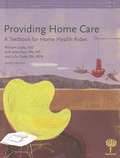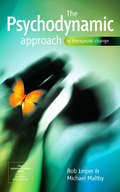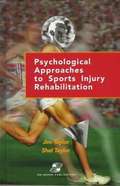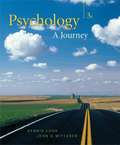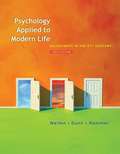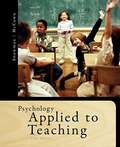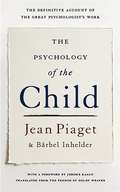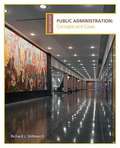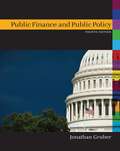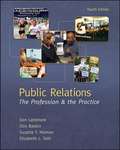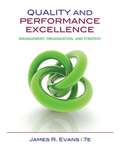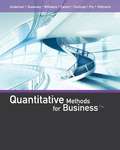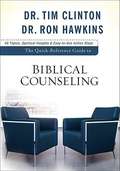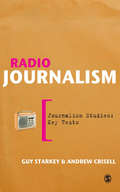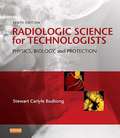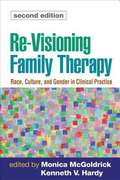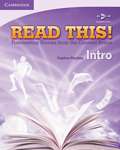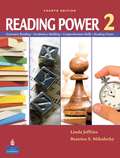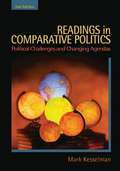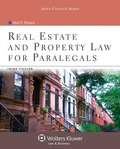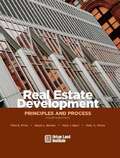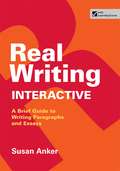- Table View
- List View
Property Management (4th edition)
by Walter Roy Huber Arlette Lyons William H. PivarUnderstanding the use and meanings of the terminology found in this textbook is paramount to a successful career in the real estate property management field.
Providing Home Care: A Textbook for Home Health Aides (4th Edition)
by William Leahy Jetta Fuzy Julie GrafeThe book presents content that reflects state and federal training requirements, OSHA regulations, and current CDC guidelines and "Green" material that discusses ways to be environmentally friendly.
The Psychodynamic Approach to Therapeutic Change (SAGE Therapeutic Change Series)
by Rob Leiper Michael Maltby`It is well written and well organised and I'm sure it will be of help and interest to researchers and practitioners concerned with the therapeutic action of psychodynamic treatment' - Penelope Waite, Nurturing Potential Change is the central purpose of all counselling and psychotherapy, but how it is conceptualized and worked with varies according to the theoretical approach being used. The Psychodynamic Approach to Therapeutic Change explores the nature of psychological change from the psychodynamic perspective and describes the process through which clients can be helped to come to terms with painful experiences and develop new ways of relating. In the first part of the book, Rob Leiper and Michael Maltby look at therapeutic change in relation to psychological health and maturity. They explore what motivates people to change and also why resistance occurs. The main part of the book outlines the collaborative process that clients and therapist work through to bring about change and highlights the role of the therapist in: ] creating the conditions for clients to express their thoughts, feelings and memories ] developing clients' awareness and understanding of their psychological processes, and ] providing `containment' for the client's psychological projections. The final part of the book sets personal therapeutic change in a wider social context, linking individual change with community and organisational development. Combining core psychodynamic concepts with contemporary thinking, The Psychodynamic Approach to Therapeutic Change provides a lively and up-to-date integration of ideas on the change process which will be of great value to trainees and practicing counsellors and psychotherapists.
Psychological Approaches to Sports Injury Rehabilitation
by Jim Taylor Shel TaylorIn dedicating this guide for rehabilitation specialists, consultants J. Taylor and S. Taylor (U. of Connecticut Health Center, Farmington) refer to frustration and patience as well as to pain and expertise, recognizing that bouncing back from sidelining sports injuries entails mind as well as body. Augmented by celebrity soundbites, the authors detail the referral process for assessing psychological problems; mental influences on rehabilitation (motivation, anxiety, focus); facilitatitive techniques (imagery, using negative thinking positively, pain management, social support); return to the sport; and development of a psychological rehab program (with sample forms, program prescription summaries). Annotation c. by Book News, Inc., Portland, Or.
Psychology: A Journey
by Dennis Coon John O. MittererIn a course where professors are frequently confronted by students who haven't actually read their textbooks, this text offers a solution. The shortest, most succinct of the books written by Dennis Coon, PSYCHOLOGY: A JOURNEY presents psychology in a way that sparks readers' curiosity, insights, imagination, and interest getting students "hooked" on psychology and eager to read on. The first author to integrate the proven SQ4R (survey, question, read, recite, relate, and review) active learning system into a psychology textbook, Coon helps readers grasp major concepts, develop a broad understanding of psychology's diversity, and see for themselves how psychology relates to the challenges of everyday life. Because readers become actively involved with the material, they develop a basic understanding of psychology that they take with them into their future courses and careers.
Psychology Applied to Modern Life: Adjustment in the 21st Century (10th Edition)
by Wayne Weiten Dana S. Dunn Elizabeth Yost HammerFilled with comprehensive, balanced coverage of classic and contemporary research, relevant examples, and engaging applications, this book shows you how psychology helps you understand yourself and the world--and uses psychological principles to illuminate the variety of opportunities you have in your life and your future career.
Psychology Applied to Teaching (13th Edition)
by Jack Snowman Rick Mccown Robert BiehlerPsychology Applied to Teaching, 13th Edition combines fresh concepts and contemporary research with long-standing theory and applications to create a book that addresses the needs of today's teachers and students.
The Psychology of the Child
by Jean Piaget Barbel InhelderPiaget’s influence on psychology has been profound. His pathbreaking investigations and theories of cognitive development have set child psychology moving in entirely new directions. His bold speculations have provided the inspiration for the work of others. His studies have been the subject of many books and countless articles. And, significantly, his influence has spread to other disciplines and is having an ever-growing impact on the general culture at large.Here Jean Piaget, with the assistance of his long-time collaborator Bärbel Inhelder, offers a definitive presentation of the developmental psychology he has elaborated over the last forty years. This comprehensive synthesis traces each stage of the child’s cognitive development, over the entire period of childhood, from infancy to adolescence.
Public Administration: Concepts and Cases (9th Edition)
by Richard J. Stillman IIThe book offers a unique and highly regarded framework in which conceptual readings are paired with contemporary case studies that reflect real-world examples of administrative work, as well as new thinking and developments in the field. Case studies and examples cover topics such as the Columbia space shuttle disaster, the shootings at Columbine High School, and the war in Iraq, making it easy to engage students in the readings.
Public Finance And Public Policy 4th Ed
by Jonathan GruberJonathan Gruber's groundbreaking Public Finance and Public Policy was the first textbook to truly reflect the way public policy is created, implement, and researched. Like no other text available, it integrated real-world empirical work and coverage of transfer programs and social insurance into the traditional topics of public finance. From its first edition, the book quickly became the market-leading text for Public Finance and Public Policy courses, and the margin is growing. Thoroughly updated, this timely new edition gives students the basic tools they need to understand the driving issues of public policy today, including healthcare, education, global climate change, entitlements, and more.
Public Relations: The Profession and the Practice, 4th Edition
by Dan Lattimore Otis Baskin Suzette T. Heiman Elizabeth L. TothThis edition retains the four-part organization of earlier editions: the profession, the process, the publics, and the practice. Part 1 describes the current public relations situation, its historical roots, theories, and ethical and legal concerns. Part 2 examines the core issues of the process that underlie public relations. Part 3 focuses on the publics that are the object of these efforts. Part 4 summarizes the practice of public relations and looks at the emerging trends of the profession.
Quality and Performance Excellence: Management, Organization, and Strategy (Seventh Edition)
by James R. EvansDelivering cutting-edge coverage that includes the latest thinking and practices from the field, QUALITY AND PERFORMANCE EXCELLENCE, 7th Edition presents the basic principles and tools associated with quality and performance excellence using relevant, real-world illustrations and examples. The text thoroughly illustrates how these basic principles and methods have been put into effect in a variety of organizations. It also illustrates the relationship between basic principles and the popular theories and models studied in management courses. Excellent case studies focus on large and small companies in manufacturing and service industries in North and South America, Europe, and Asia-Pacific.
Quantitative Methods for Business
by David R. Anderson Dennis J. Sweeney Thomas A. Williams Jeffrey D. Camm James J. Cochran Michael J. Fry Jeffrey W. OhlmannWritten for the current or future business professional, QUANTITATIVE METHODS FOR BUSINESS, 13E makes it easy for you to understand how you can most effectively use quantitative methods to make smart, successful decisions. The book's hallmark problem-scenario approach guides you step by step through the application of mathematical concepts and techniques.
Quantum Field Theory in Curved Spacetime
by Leonard E. Parker David J. TomsIn this book, Robert Wald provides a coherent, pedagogical introduction to the formulation of quantum field theory in curved spacetime. He begins with a treatment of the ordinary one-dimensional quantum harmonic oscillator, progresses through the construction of quantum field theory in flat spacetime to possible constructions of quantum field theory in curved spacetime, and, ultimately, to an algebraic formulation of the theory. In his presentation, Wald disentangles essential features of the theory from inessential ones (such as a particle interpretation) and clarifies relationships between various approaches to the formulation of the theory. He also provides a comprehensive, up-to-date account of the Unruh effect, the Hawking effect, and some of its ramifications. In particular, the subject of black hole thermodynamics, which remains an active area of research, is treated in depth.
The Quick-Reference Guide to Biblical Counseling: Personal and Emotional Issues
by Tim Clinton Ron HawkinsBut sometimes those who are faced with helping the hurting could use a little more information about the problems people bring to them. The Quick-Reference Guide to Biblical Counseling provides the answers. This A-Z guide gives pastors, counselors, and everyday believers the information they need to help congregants, clients, and friends in a wide array of situations. The many issues addressed include Addictions Burnout Forgiveness Sexual abuse in childhood Worry Each of the forty topics covered follows a helpful eight-part outline and identifies typical symptoms and patterns, definitions and key thoughts, questions to ask, directions for the conversation, action steps, biblical insights, prayer starters, and recommended resources. Book jacket.
Radio Journalism (Journalism Studies: Key Texts)
by Andrew Crisell Guy Starkey"This is not another turgid guide to digital editing, writing for radio and the structure of a newsroom team. It is an ambitious and accessible study that combines a succinct narrative history of radio journalism with an analysis of its power in the public sphere. It describes the development of British audio broadcasting before locating it in an international context and contemplating the contours of the convergent future. Such ambition is often the prelude to failure. Instead, Starkey and Crisell have written a precious introduction to the theory, practice and purposes of radio journalism that will be very useful to serious students of the subject... This is a very good book." - THE (Times Higher Education) Radio Journalism introduduces key themes in journalism studies to explore what makes radio reporting distinctive and lay out the claims for radio's critical importance in the news landscape. With their extensive experience in radio production and academica, authors Guy Starkey and Andrew Crisell take readers on a tour through the past, present and future of radio broadcasting, from the infancy of the BBC in the 1920s up to the prospect of rolling news delivered to mobile telephones. Grounding each chapter in a survey of scholarly writing on the radio, they explore the connections between politics, policy and practice, inviting critical reflection on who radio professionals are, what they do and why. Putting theory and practice into dialogue, this book is the perfect bridge between unreflective production manuals and generalised media theory texts. Witty and engaging, Radio Journalism provides an essential framework for understanding the continuing relevance of radio journalism as a profession, set of practices and arena for critical debate. ks within particular types of journalism; a review of contemporary practices; social demographics; a comparative analysis of practices around the world; a summary of main conceptual approaches; an indication of future directions; recommendations for further reading. This strong organization resembles a template for a course outline. This is intentional because the series is aimed both at students and their practice-based lecturers, who often come straight from industry and need time to adjust to the academic environment... [The series] achieves its aim to bridge the sometimes too evident dissonance between journalism theory and practice... They successfully situate discussions about journalism in social and historical contexts. We see the faces of individual journalists, the circumstances of news production, the relationship with owners, the battle between the public service and the profit nature of news, the relevance of journalism work. The detailed account of the conditions under which newspaper, radio and alternative journalism is produced and performed make the Journalism Studies: Key Texts series mandatory reading for both journalism students and their lecturers' - Verica Rupar, Journalism Studies
Radiologic Science for Technologists: Physics, Biology and Protection (10th Edition)
by Stewart Carlyle BushongThis textbook provides a solid presentation of radiologic science, including the fundamentals of radiologic physics, diagnostic imaging, radio biology, and radiation management.
Re-Visioning Family Therapy: Race, Culture, and Gender in Clinical Practice (Second Edition)
by Monica Mcgoldrick Kenneth V. HardyNow in a significantly revised and expanded second edition, this groundbreaking work illuminates how racism, sexism, and other forms of oppression constrain the lives of diverse clients -- and family therapy itself. Practitioners and students gain vital tools for re-evaluating prevailing conceptions of family health and pathology; tapping into clients' cultural resources; and developing more inclusive theories and therapeutic practices. From leaders in the field, the second edition features many new chapters, case examples, and specific recommendations for culturally competent assessment, treatment, and clinical training. The section in which authors reflect on their own cultural and family legacies also has been significantly expanded.
Read This! Intro Student's Book: Fascinating Stories From The Content Areas
by Daphne MackeyRead This! is a four-book reading series designed for adult and young adult ESL students at the high beginning to intermediate levels. Read This! Intro contains fifteen fascinating stories relating to the fields of Education, Sociology, Science, Marketing, and TV and Film Studies. For example, students read about schools in which students, not teachers make the rules; apartments that are designed to be difficult to live in; and reality TV shows in which the audience likes the meanest judges the best. These non-fiction stories are written in an accessible narrative style and are appropriate for high beginning students. Illustrated with attractive color photos, this low-level reading book will motivate even the lowest level reading students to start reading content-rich texts.
Reading Power 2 (Fourth Edition)
by Linda Jeffries Beatrice S. MikuleckyReading Power 2 is a new and updated edition of the successful student-centered reading skills textbook Reading Power. Its unique structure, featuring four parts to be used concurrently, allows low-intermediate-level students (with a 600-word vocabulary) to develop the multiple sills and strategies involved in the reading process. Overview Extensive Reading helps students to build reading fluency, broaden knowledge of vocabulary and collocation, and gain confidence. Vocabulary Building offers strategies for independent vocabulary learning such as dictionary work, guessing meaning from context, and learning how words work in sentences. Comprehension Skills teaches reading skills such as recognizing words and phrases, scanning for information, and making inferences. Reading Faster builds awareness of reading speed, provides strategies and exercises for increasing speed, and offers charts for tracking progress. New to the Fourth Edition An updated Extensive Reading section with a unit on fiction and non-fiction reading, more activities for evaluating student progress, and a revised suggested reading list Enhanced vocabulary features including new "Focus on Vocabulary" exercises and an expanded Vocabulary Building section There is also a Teacher Guide with Answer Key and a Test Booklet for Reading Power 2. The Reading Power series also includes: Basic Reading Power 1 (Third Edition): Beginning Reading Power 2 (4th Edition): Intermediate More Reading Power 3: High-Intermediate Advanced Reading Power 4: Advanced
Readings in Comparative Politics: Political Challenges and Changing Agendas (2nd Edition)
by Mark KesselmanWith a collection drawn from a variety of published, unpublished, and electronic sources, the book offers students a good sample of the wide range of popular and scholarly views relevant to the major topics presented in introductory comparative courses. The book contains seven Chapters, viz., Introduction, States and Regimes, Governing the Economy, the Democratic Challenge, Collective Identity, Political Institutions and Political Challenges and Changing Agendas.
Real Estate and Property Law for Paralegals
by Bevans Neal R. BevansReal Estate and Property Law for Paralegals provides a solid foundation in the basics including the practicalities of daily legal work. Its broad coverage of all the key topics that paralegals need to know includes basic elements of real property, different methods used to record and describe property, transfer of title, the rights associated with real estate ownership,elements of real estate contracts, landlord/tenant law, deeds, mortgages,restrictions on land use, title insurance and title examinations, the closing process, and tax implications. Practical skills are emphasized throughout the book so that students will develop a true understanding of what it is like to practice in the real world. An easy-to-read and engaging style utilizes numerous examples and illustrations, always emphasizing the practical nature of real estate law. Each chapter opens with objectives and closes with Key Terms, Review Questions, and Practical Applications exercises. In every chapter, an "Issue at a Glance" box summarizes important legal concepts, and"Skills You Need in the Real World" sections highlight particular paralegal skills. Marginal definitions; numerous figures, tables, and forms; and case excerpts that discuss legal theory and applications round out the significant pedagogy. Additionally, Websites that can help students gather more information are strategically placed. An in-depth Instructor's Manual includes a test bank, lesson plans, suggested syllabi, web resources, additional assignments and PowerPoint slides for each chapter. The revised Third Edition provides a wealth of updated forms and cases. New website references make the book current, and fine-tuned text discussions have been expanded where appropriate. A new interactive workbook is available at the website to accompany the book.
Real Estate Development: Principles and Process
by Mike E. Miles Marc A. Weiss Gayle L. Berens Mark J. EppliIdeal for anyone new to real estate development, the fourth edition of this bestselling book covers each stage of the process step by step, explaining the basics of idea conception, feasibility, planning, financing, market analysis, contract negotiation, construction, marketing, and asset management. Thoroughly updated, the book includes material on financing and marketing.
Real Writing Interactive
by Susan AnkerReal Writing Interactive offers practical coverage of writing skills and step-by-step guidance on crafting paragraphs and essays in a brief, interactive, and affordable format. The print component offers the essentials of Anker's accessible writing instruction along with select exercises; additional exercises are available online in LearningCurve, adaptive, game-like quizzing that helps students focus on the material they most need help with. As with all books in the Anker series, Real Writing Interactive motivates students with its message that writing is an essential and achievable skill and encourages students to connect what they learn with their own goals and with the needs and expectations of the larger world.

